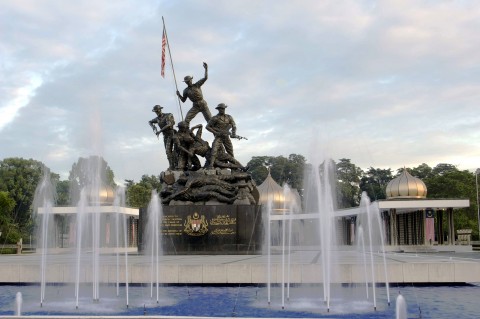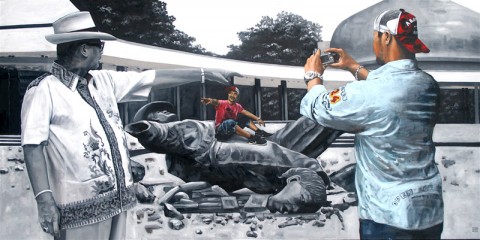

[Random acts of silencing continue. This time, one mainstream tabloid’s folly is ARTERI’s gain. Sharaad Kuttan’s latest piece about the Tugu Negara (National Monument) for his column ‘The Pedestrian’ was spiked (read: rejected) for publication. Maybe it was the fact that the word ‘communist’ was mentioned more than once. Whatever the reason, he has very kindly allowed us to publish it here – SC]

Tugu Negara or National Monument. Image source here.
Between the Government of Malaysia’s national memorial, Tegu Peringatan Negara, a stone’s throw from the Parliament building in Kuala Lumpur, and the Communist Party of Malaya’s memorial at Princess Chulaporn Village No. 10 in southern Thailand, is a history that remains deeply contested.
However as the country moves further away from the events that symbolize that history – World War Two, the Malayan Emergency and the Cold War primarily – both monuments have come to, ironically suffer the same fate. Both lie deep in the shadow of the KLCC’s Twin Towers.
The dream of modernization, consumerism as well as global political and corporate leadership is central to the meaning of the gleaming towers. From here the global TV network, Al-Jazeera, broadcasts to the world. To these towers to come the city’s tourist, the corporate elite, aficionados of Western classical music, and day trippers enjoying one of the city’s nicest, if private, parks.
The Towers have come only to define the city’s skyline and serves as the nation’s most reproducible street-level icon – disseminated through the most mundane of objects like t-shits, paper-weights and on postcards.
The Tugu Peringatan comes with an altogether different set of meanings; ones so contested that it suffered a bomb attack on August 26, 1975 by a group calling themselves the National Liberation Front of Malaya.

Recollections of Long Lost Memories #2 by Ahmad Fuad Osman. Image source here.
A decade or so later at the peace talks between the government of Malaysia and the Communist Part of Malaya the question of the monument had been raised. Chin Peng on page 486 of his memoirs, “Alias Chin Peng, My Side of History” notes: “We further asked that the Kuala Lumpur War Monument featuring representations of Malaysian and British Commonwealth troops stepping on a fallen communist guerilla be demolished.”
The CPM also asked for a replacement. When asked for a suggestion the “delegates suggested one that depicted the three main races of Malaysia – Malay, Chinese and Indian – fighting together for independence.” This is how Chin Peng describes it.
This demand was among many on the peace agenda which was put aside because as Chin Peng recalls the Malaysian government argued that the monument had based on an Act of Parliament and required another to replace it. However for the CPM the urgent business of achieving peace trumped the question of historic representation and they reluctantly put it aside.
This question of representation is an important one. I once chanced upon a letter to the editor of an English daily and cut it out. Here one Zhang Meisuo writes: “The National Monument at the lake Gardens in Kuala Lumpur is a wonderful place to visit and meaningful for a nation. However, something there seems not quite right. I refer to the seven bronze statues. Their uniform, stature and looks are more like Caucasians. … My suggestion is change the statues of the monument in such a way so that they represent and stand for the Malaysian people who have been the true heroes of the land.”
This anxiety about the ‘racial’ features of the soldiers is indicative of the way in which our official national history has been constructed. How much can it acknowledge the involvement of larger Imperial forces in our liberation story without undermining the ‘heroic’ character of the Malayans involved?
Did the writer mean to have us to literally chip out the “Caucasian” character of the Emergency of 1948-1960. A couple of years ago we might have even been able to enlist the Viennese-born American sculptor Felix de Weldon, commissioned to fashion the monument in the sixties, in this curious task. He was not above revisiting previous work “authorized a special edition of his iconic sculpture The Flag Raising On Iwo Jima”, calling it United We Stand. Unfortunately he died in 2003 at the age of 96.
Interestingly enough the monument has undergone a subtle re-branding with the inclusion to the dedication of “Our Glorious Dead” from the two other wars, World War One (194-1918) and World War Two (1939-1945). Needless to say this further confuses the question of who was Malayan in these wars, and continues to omit the wars fought in the Borneo half of the country.
Again, only with intellectual honesty and openness can we begin to undo our knotted but ultimately redeemable history, and save it from the cheap politicization that continues to surround it.
~
Sharaad Kuttan co-edited a collection of critical essays on cultural politics in Singapore, “Looking at Culture” (1996). Living in Kuala Lumpur since 1995, he is currently a copy editor with the Malay Mail and teaches part-time at Sedaya University.
Sorry, the comment form is closed at this time.
Sorry, I don’t think this qualifies as ‘random acts of silencing’. If I was an editor, I would reject this piece too. The topic is profound, but the piece is not well-written.
1) How is the Communist Party of Malaya’s memorial in Thailand ‘overshadowed by KLCC’?
2)Paragraph 3 and 4 do not contribute anything whatsoever to the article’s topic.
Also, I’m not a professional editor, but I already saw a few grammatical errors.